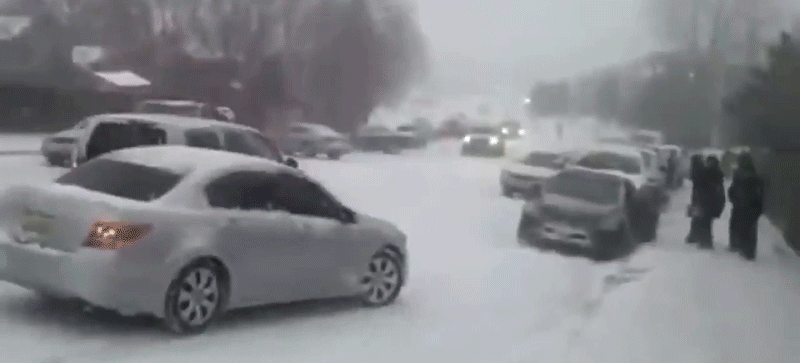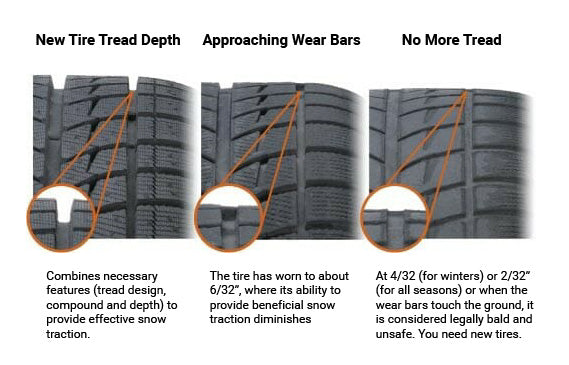Your Cart is Empty
Menu

Sedans & Hatchbacks
Small Crossovers (CUVs)
Large Crossovers (SUVs)
Sports Cars
Add description, images, menus and links to your mega menu
A column with no settings can be used as a spacer
Link to your collections, sales and even external links
Add up to five columns
Add description, images, menus and links to your mega menu
A column with no settings can be used as a spacer
Link to your collections, sales and even external links
Add up to five columns

Complete Winter Tire Guide - Everything you need to know! All-Season VS All-Weather VS Winter Tires!
October 06, 2016 5 min read
Let’s think of this way, if you change your shoes accordingly to the weather, then why don’t you change the “shoes” (tires) for your car as the weather changes too?
As motorists, every year we experience the horrendous wet and slippery driving conditions mother nature brings to us, also referred to as snow and ice. There is nothing scarier than the feeling of your vehicle skidding uncontrollably as you continuously pump the brakes in hopes of stopping your vehicle in time (whether it is into another vehicle, onto oncoming traffic, into an intersection, or as you try to come to a stop). Sure, you may have had a few similar encounters before and was lucky enough to avoid accidents, but luck is not dependable and the only real way to increase winter driving safety, is to equip winter tires on your vehicle.
Not only do winter tires increase your personal safety, it also decreases the chances of accidents or damages to you, your car and everyone else on the road.
 Source: i.kinja-img
Source: i.kinja-img
Over-view
- Winter tires are optimized for cold temperatures as the specialized rubber compounds are formulated to stay flexible in order to make contact with the road and to overcome winter conditions.
- 7°C is the prime time to swap over to winter tires!
- Stopping distance on snow, ice or cold pavement can be 30%-40% less for vehicles with winter tires – makes a drastic difference in road safety!
- It does not matter what car you drive or your experience on the road, winter tires are optimized for winter driving conditions.
- The amount of traction the winter tires you choose will ultimately determine your vehicle's starting, stopping and turning (handling) performance - remember to check out the specifications and abilities of the tires!
- Downsizing - it’s cost saving and beneficial: Smaller and narrower tire has better grip and performance as it cuts through more effectively as the weight of your vehicle is more focused on a specific contact area.
- Winter tire packages with steel wheels save costs and time in the long run!
- Full set of the same winter tires are required for maximum performance and handling
- Choose a size that will deliver the perfect combination of ride and style for you.
- Check the “wear bars” on your tires to determine how much life is left on your winter tires – otherwise they will no longer provide you with winter performance.

Source: tumblr.com
Winter tires vs All season vs All weather?
Winter tires are not simply just for when there is snow or ice. The golden number to remember is 7°C! Each tire type has its temperature range it is optimized for. Summer tires like it hot, all-season likes moderate temperatures, winter tires like it cold, and all-weather tires can function in a temperature range that just overlaps both all-seasons and winter tires (above and below 7°C). At 7°C the rubber compound in winter tires and all-weather tires have much better traction (grip) as they are designed and made with highly specialized rubber compounds that will stay soft and flexible in cold weather. This allows the tires to stay flexible and make better contact with the road than all-season tires which start to harden as the temperature drops – losing traction.
All-season tires are designed for warm, dry and mildy wet conditions. They perform best at temperatures about 7°C. They are made with a harder compound in order to get longer lasting tread life, but the downside is that they will lose traction when temperatures drop below 7°C.
All-weather tires are designed for mild winter conditions, heavy rain, wet snowfall, slush, and on bare asphalt. They perform at temperatures above and below 7°C. Unfortunately, they do not perform as well as winter tires do on ice and soft and hard-packed snow. Also, alll-weather tire composition typically do not last as long as winter or all-season tires due to the tire's composition to withstand the wide range of temperatures.
Winter tires come in studded and non-studded versions. Studded tires have metal stubs that will help with braking on icy roads. Winter tires are designed for harsh conditions with lots of snow, ice and freezing water on the road. They have maximum performance at temperatures below 7°C. These tires will remain soft in cold weather allow for maximum traction and grip on winter road conditions.
Winter tires also have advanced tread designs that will provide your vehicle with shorter stopping distance compared to all weather and all season tires. Winter tires will help you increase braking and stopping ability in winter conditions, and they are also optimized to overcome winter conditions such as slush, unplowed snow or ice.
There are many different winter tires on the market, and as you shop for the perfect winter tires specifically for you, you have to keep in mind the severity of winter conditions in your area and the specific vehicle you have.
Equipping winter tires not only increase safety, it also help with increasing the life of your all-season tires as all-season tires wear out much faster in the cold weather.

Source: rubberassociation.ca
Winter tires specifically have this symbol on them which indicates that are designed specifically for winter conditions and that they meet specific snow traction performance. All-weather tires will also have this symbol as they are able to peform under mild winter conditions.
Do I need a full set of tires?
A full set of winter tires are required as the compound and tread differs from all-weather tires. If you put a pair of winter tires and a pair of all-season tires on your vehicle, the tires will react differently to the driving conditions and will tamper with acceleration, braking, control and handling.
Is it time for new tires?
There is a method to determine if it’s time to retire your current winter tires. The lifespan of your winter tires is dependent on the amount driven on it, the driving habits of the driver, and the conditions it has gone through. First and most importantly, you have to check for any cracking or chafing of the tires on the side walls! There are “wear bars” which are built-in tread wear indicators. These are small raised bars that run along the tire grooves. If the wear bars are even with the tread, then this is a sign that your tires need to be replaced as they will no longer provide your vehicle with winter performance.

Source: car.blog.ca
Downsizing/Minus Sizing
We all love the big and stylish wheels that gives our ride the extra kick in both looks and performance, but unfortunately in the winter, you can only win in one department: looks or performance.
Minus Sizing or downsizing refers to using smaller diameter wheels with taller and narrower winter tires. This will put less rubber in contact with the road and in return, improves your vehicle’s traction and handling in winter conditions by increasing the pressure at the tread contact patch. With the increased pressure and narrower tread face, it allows the tire to better cut through snow, slush and also displace the thin film of water (occurs when the tire presses down on snow or ice, melting the top layer = water) that causes loss of traction on icy surfaces.
Another advantage to downsizing is that it is more cost efficiency as smaller wheels are less expensive, and if you get a tire package with steel wheels, you will save even more money and time in the long run. This is because you will not have de-mount, re-mount and balance every time. Don’t forget - you can always throw on stylish hub caps on steel wheels!
One way to know which size to downsize to, is to use the base model specifications for your vehicle.
Check out our collection of beautiful Mazda Wheels here!
Check out our collection of Mazda Winter Tire Packages here!
Go on, get your winter tires on as soon as possible and conquer the winter!

Source: giphy.com
Subscribe
Sign up to get the latest on sales, new releases and more …














